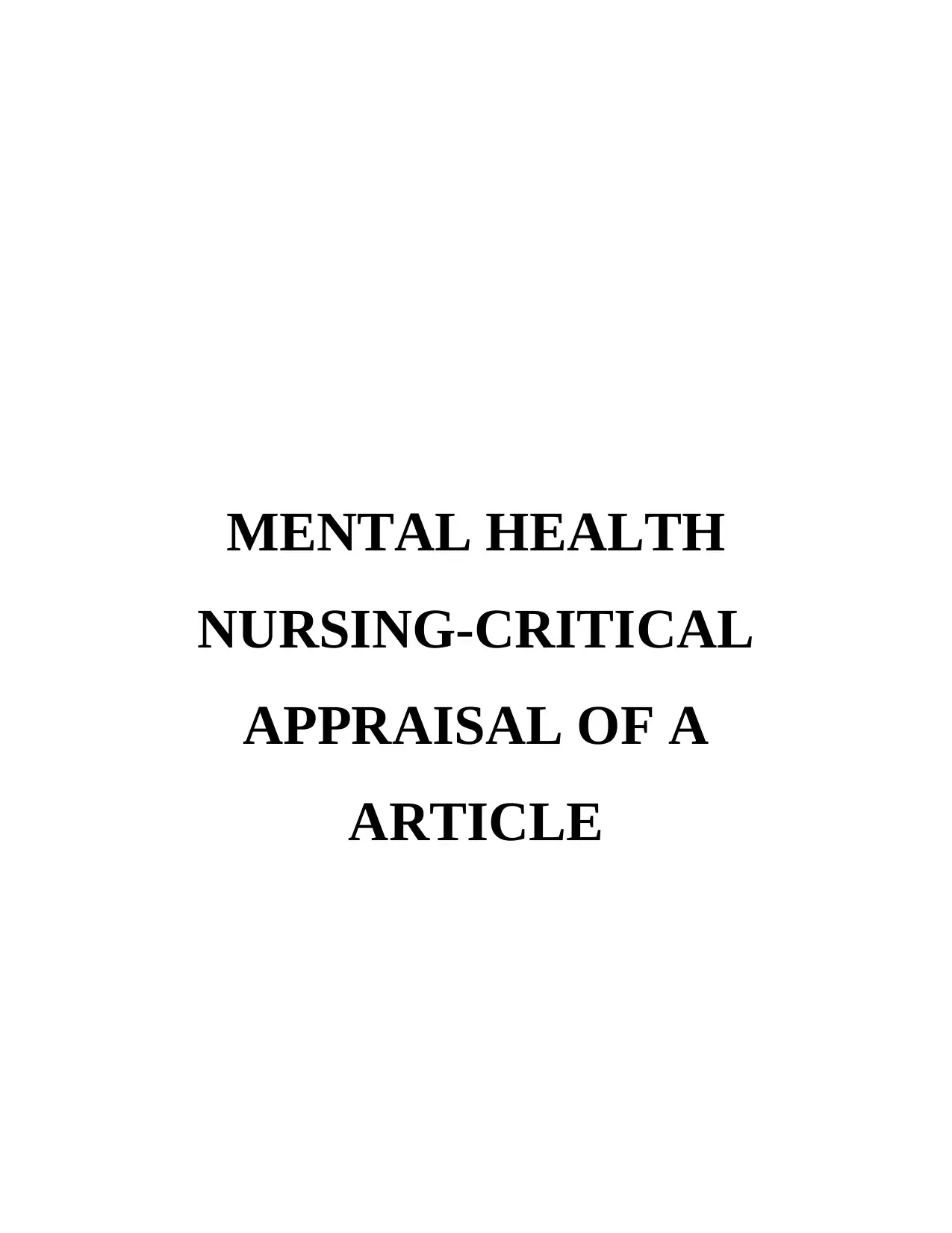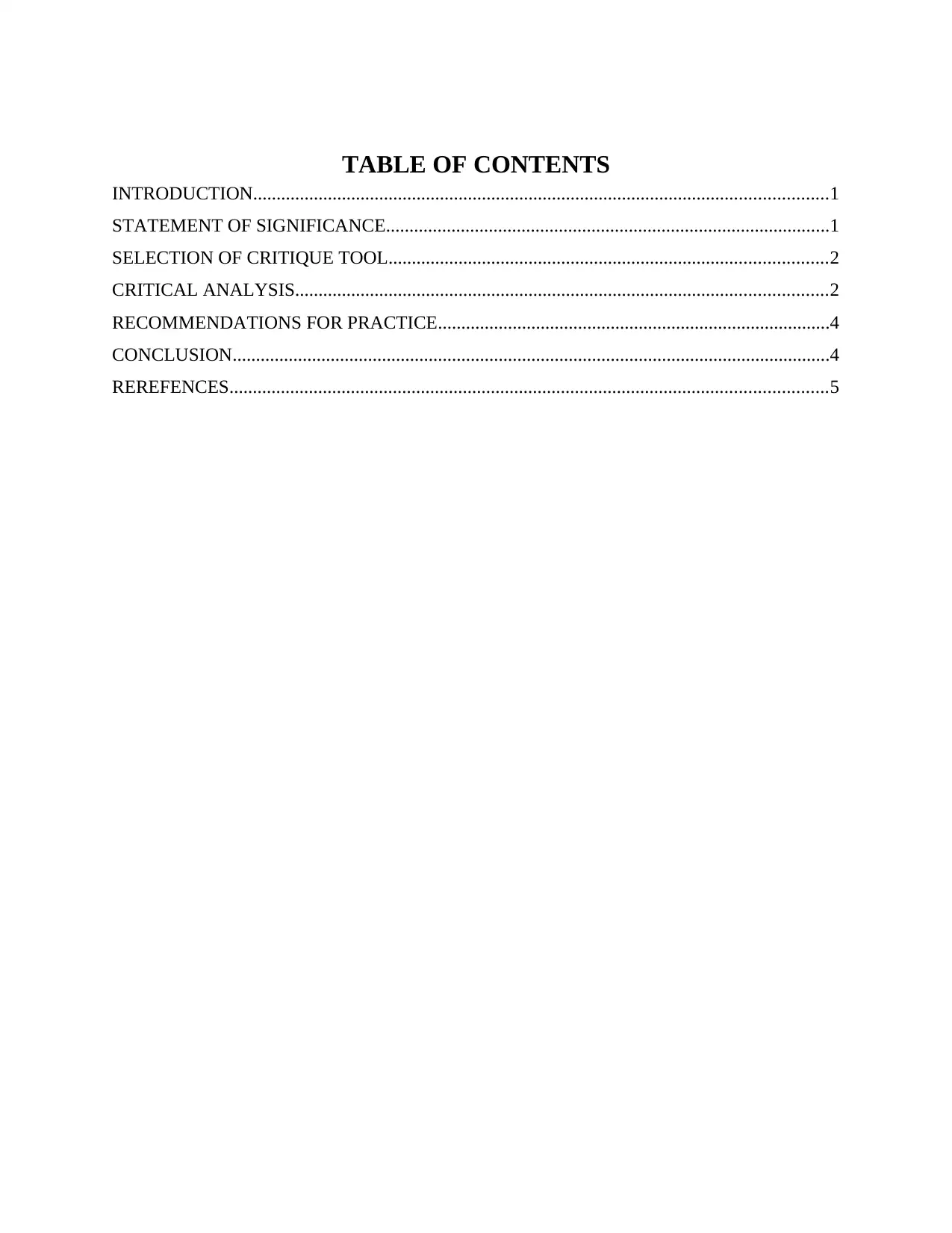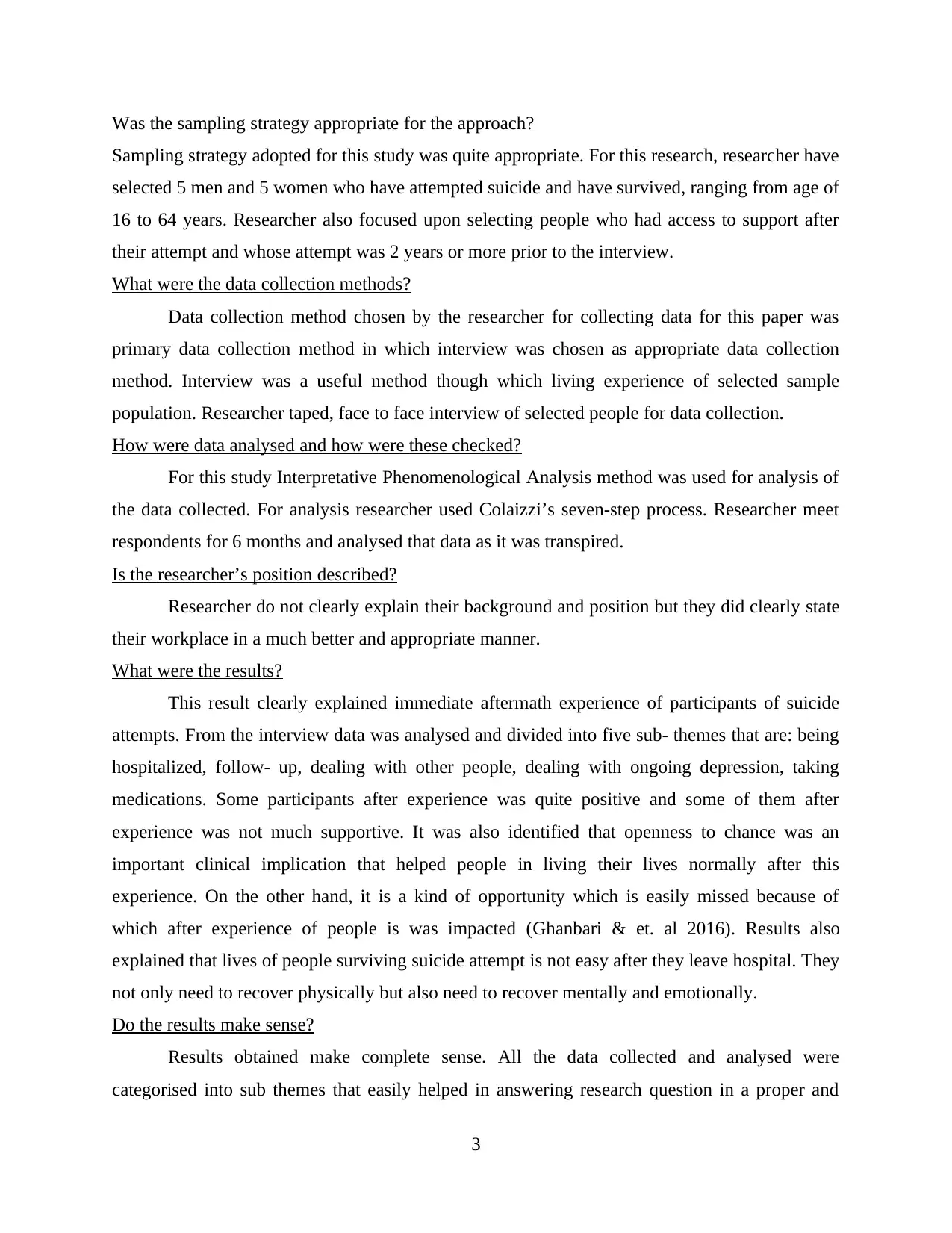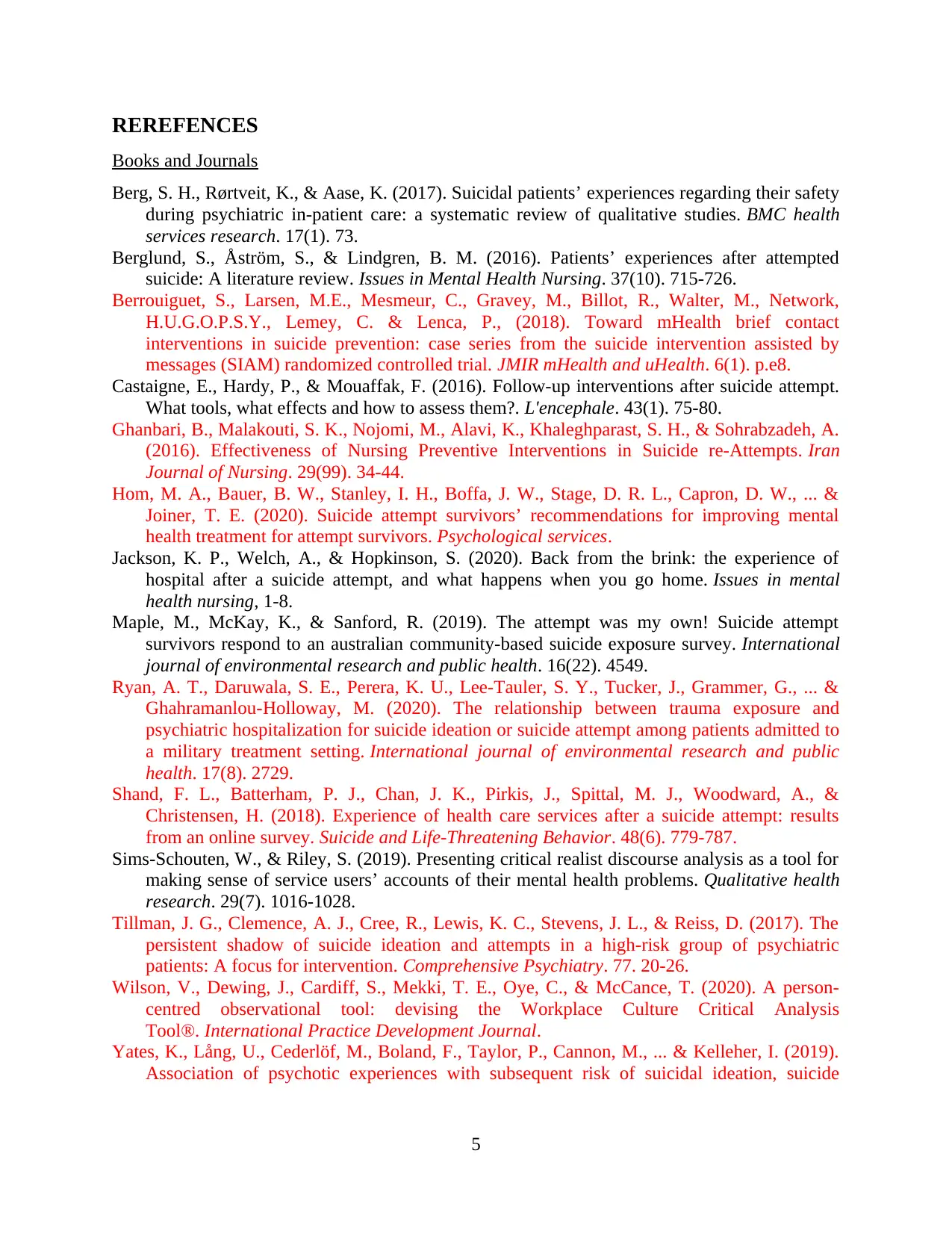Critical Analysis: Mental Health Nursing Article on Suicide Attempts
VerifiedAdded on 2023/01/09
|8
|2588
|93
Report
AI Summary
This report presents a critical appraisal of the research article, 'Back from the Brink: The Experience of Hospital after a Suicide Attempt, and What Happens When You Go Home' by Jackson, Welch & Hopkinson (2020). The paper investigates the experiences of individuals who survive suicide attempts, focusing on their hospitalizations, discharges, and subsequent home lives, including challenges related to suicidal tendencies, social interactions, and medication side effects. The analysis employs the CASP qualitative checklist to critically evaluate the article's rationale, methodology, data analysis, and conclusions. The report examines the appropriateness of the qualitative approach, sampling strategies, data collection methods, and the validity of the results. The findings are assessed for their transferability to other clinical settings. Recommendations are provided to enhance clinical practice, such as the need for improved training for healthcare professionals and timely follow-up interventions. The report emphasizes the importance of providing comprehensive care and support to individuals who have survived suicide attempts, considering their vulnerability and need for both physical and mental recovery.

MENTAL HEALTH
NURSING-CRITICAL
APPRAISAL OF A
ARTICLE
NURSING-CRITICAL
APPRAISAL OF A
ARTICLE
Paraphrase This Document
Need a fresh take? Get an instant paraphrase of this document with our AI Paraphraser

TABLE OF CONTENTS
INTRODUCTION...........................................................................................................................1
STATEMENT OF SIGNIFICANCE...............................................................................................1
SELECTION OF CRITIQUE TOOL..............................................................................................2
CRITICAL ANALYSIS..................................................................................................................2
RECOMMENDATIONS FOR PRACTICE....................................................................................4
CONCLUSION................................................................................................................................4
REREFENCES................................................................................................................................5
INTRODUCTION...........................................................................................................................1
STATEMENT OF SIGNIFICANCE...............................................................................................1
SELECTION OF CRITIQUE TOOL..............................................................................................2
CRITICAL ANALYSIS..................................................................................................................2
RECOMMENDATIONS FOR PRACTICE....................................................................................4
CONCLUSION................................................................................................................................4
REREFENCES................................................................................................................................5

INTRODUCTION
The paper selected for critical appraisal was ‘Back from the Brink: The Experience of
Hospital after a Suicide Attempt, and What Happens When You Go Home’ by Jackson., Welch
& Hopkinson, 2020. In this paper researcher has focused upon individuals who survive suicide
attempt and has explained their experience of being hospitalise, discharged and returning home
with same suicidal tendency (Jackson, Welch & Hopkinson., 2020)). This paper also focuses
upon difficulties they face with other people, side effects of medicines. For critical analysis of
this paper CASP qualitative checklist critical tool will be used in which few questions related to
the paper are asked for critical analysis of the paper. This paper has two main objectives: First
objective is to critically analyse chosen paper using appropriate tool and second main objective is
to provide recommendations to make practise chances on the basis of information present in the
article.
STATEMENT OF SIGNIFICANCE
This topic is an important topic for mental illness speciality area due to various reasons.
Suicide attempt is a kind of mental illness which is not much discussed or focused upon. It is an
important topic which is most often neglected (Shand & et. al. 2018Berglund, Åström &
Lindgren, 2016). Experience of people who survive suicide attempts is often neglected. This
paper is important and can contribute till a great extent in field of suicidology. This topic is also
important to understand legislative acts that have been developed in this field, practises and
policies that have been developed or are being worked upon in this field. So that any kind of
changes required to be brought within current legislation, procedures and policies can be taken.
According to the view of Berg, Rørtveit & Aase, (2017) suicide attempt is a serious kind
of problem that requires mental health interventions. Considering it as a serious issue national
level suicide prevention implications or strategies have been developed and are included in
Mental health Act, 2014 (Yates & et. al. 2019). In fact, on the basis of this Act Victorian suicide
prevention framework has also been developed by government so that increasing number of
suicide cases can be reduced and mental health of people who are at greater risk of suicide can be
improved in a much better and appropriate manner (Hom & et. al. 2020). For this government
has also established an administrative department known as SAMHSA for substance abuse and
mental health service administration in which different kinds of strategies of preventing suicide
are being focused upon and ways in which their mental health can be improved or enhanced is
1
The paper selected for critical appraisal was ‘Back from the Brink: The Experience of
Hospital after a Suicide Attempt, and What Happens When You Go Home’ by Jackson., Welch
& Hopkinson, 2020. In this paper researcher has focused upon individuals who survive suicide
attempt and has explained their experience of being hospitalise, discharged and returning home
with same suicidal tendency (Jackson, Welch & Hopkinson., 2020)). This paper also focuses
upon difficulties they face with other people, side effects of medicines. For critical analysis of
this paper CASP qualitative checklist critical tool will be used in which few questions related to
the paper are asked for critical analysis of the paper. This paper has two main objectives: First
objective is to critically analyse chosen paper using appropriate tool and second main objective is
to provide recommendations to make practise chances on the basis of information present in the
article.
STATEMENT OF SIGNIFICANCE
This topic is an important topic for mental illness speciality area due to various reasons.
Suicide attempt is a kind of mental illness which is not much discussed or focused upon. It is an
important topic which is most often neglected (Shand & et. al. 2018Berglund, Åström &
Lindgren, 2016). Experience of people who survive suicide attempts is often neglected. This
paper is important and can contribute till a great extent in field of suicidology. This topic is also
important to understand legislative acts that have been developed in this field, practises and
policies that have been developed or are being worked upon in this field. So that any kind of
changes required to be brought within current legislation, procedures and policies can be taken.
According to the view of Berg, Rørtveit & Aase, (2017) suicide attempt is a serious kind
of problem that requires mental health interventions. Considering it as a serious issue national
level suicide prevention implications or strategies have been developed and are included in
Mental health Act, 2014 (Yates & et. al. 2019). In fact, on the basis of this Act Victorian suicide
prevention framework has also been developed by government so that increasing number of
suicide cases can be reduced and mental health of people who are at greater risk of suicide can be
improved in a much better and appropriate manner (Hom & et. al. 2020). For this government
has also established an administrative department known as SAMHSA for substance abuse and
mental health service administration in which different kinds of strategies of preventing suicide
are being focused upon and ways in which their mental health can be improved or enhanced is
1
⊘ This is a preview!⊘
Do you want full access?
Subscribe today to unlock all pages.

Trusted by 1+ million students worldwide

also being focused upon (). Other than this government has also established safeward model. In
this model different kinds of interventions have been developed for reduction of suicide attempts.
But Ryan & et. al. (2020) explains that all the interventions that have been developed till now
only focus upon reducing suicide attempts. Very few of them focuses upon experience of people
who survive suicide attempts (Maple, McKay & Sanford, 2019). Their expire within hospital and
homes after suicide survival. This paper is important to understand this experience.
SELECTION OF CRITIQUE TOOL
There are various kinds of tools that can be used as critique tools for critically analyse a
research paper, article etc. (Wilson & et. al. 2020). Different kinds of tools are being used for
different kinds of papers. For this paper CASP qualitative study checklist tool will be used for
this paper (Critical Appraisal, 2020). This tool consists of some series of questions and checklist
though which this paper can be analysed. Using this tool and answering 10 questions can help in
developing some sense of qualitative research (Sims-Schouten & Riley, 2019).
CRITICAL ANALYSIS
Critical analysis of paper will be by answering following questions.
Rationale of the paper
Yes, the paper does have appropriate rationale that helps in describing importance of the
problem. The main of this study is to explore living experience of people who have suicidal
tendencies or have survived suicide attempt for identification of implications for health care
professionals. Researcher has also explained importance of this topic in a proper and clear
manner. According to the researcher various kinds of legislative acts have been developed, but
very few researches have been done or conducted in this field in which experience of such
people have been observed.
Was a qualitative approach appropriate?
Yes, for this study qualitative approach was appropriate as it helped the researcher in
clearly understanding reason because of which suicidal tendencies is developed within people,
their mentality because of which they attempt suicide. So that requirement of specific model of
care for such people can be developed and ways in which medical staff members or professions
can contribute in enhancing lives of such people. Researcher says that in past research too much
focus upon quantitative data has been done because of which experience of such people is
supressed. For this study descriptive phenomenology approach was used.
2
this model different kinds of interventions have been developed for reduction of suicide attempts.
But Ryan & et. al. (2020) explains that all the interventions that have been developed till now
only focus upon reducing suicide attempts. Very few of them focuses upon experience of people
who survive suicide attempts (Maple, McKay & Sanford, 2019). Their expire within hospital and
homes after suicide survival. This paper is important to understand this experience.
SELECTION OF CRITIQUE TOOL
There are various kinds of tools that can be used as critique tools for critically analyse a
research paper, article etc. (Wilson & et. al. 2020). Different kinds of tools are being used for
different kinds of papers. For this paper CASP qualitative study checklist tool will be used for
this paper (Critical Appraisal, 2020). This tool consists of some series of questions and checklist
though which this paper can be analysed. Using this tool and answering 10 questions can help in
developing some sense of qualitative research (Sims-Schouten & Riley, 2019).
CRITICAL ANALYSIS
Critical analysis of paper will be by answering following questions.
Rationale of the paper
Yes, the paper does have appropriate rationale that helps in describing importance of the
problem. The main of this study is to explore living experience of people who have suicidal
tendencies or have survived suicide attempt for identification of implications for health care
professionals. Researcher has also explained importance of this topic in a proper and clear
manner. According to the researcher various kinds of legislative acts have been developed, but
very few researches have been done or conducted in this field in which experience of such
people have been observed.
Was a qualitative approach appropriate?
Yes, for this study qualitative approach was appropriate as it helped the researcher in
clearly understanding reason because of which suicidal tendencies is developed within people,
their mentality because of which they attempt suicide. So that requirement of specific model of
care for such people can be developed and ways in which medical staff members or professions
can contribute in enhancing lives of such people. Researcher says that in past research too much
focus upon quantitative data has been done because of which experience of such people is
supressed. For this study descriptive phenomenology approach was used.
2
Paraphrase This Document
Need a fresh take? Get an instant paraphrase of this document with our AI Paraphraser

Was the sampling strategy appropriate for the approach?
Sampling strategy adopted for this study was quite appropriate. For this research, researcher have
selected 5 men and 5 women who have attempted suicide and have survived, ranging from age of
16 to 64 years. Researcher also focused upon selecting people who had access to support after
their attempt and whose attempt was 2 years or more prior to the interview.
What were the data collection methods?
Data collection method chosen by the researcher for collecting data for this paper was
primary data collection method in which interview was chosen as appropriate data collection
method. Interview was a useful method though which living experience of selected sample
population. Researcher taped, face to face interview of selected people for data collection.
How were data analysed and how were these checked?
For this study Interpretative Phenomenological Analysis method was used for analysis of
the data collected. For analysis researcher used Colaizzi’s seven-step process. Researcher meet
respondents for 6 months and analysed that data as it was transpired.
Is the researcher’s position described?
Researcher do not clearly explain their background and position but they did clearly state
their workplace in a much better and appropriate manner.
What were the results?
This result clearly explained immediate aftermath experience of participants of suicide
attempts. From the interview data was analysed and divided into five sub- themes that are: being
hospitalized, follow- up, dealing with other people, dealing with ongoing depression, taking
medications. Some participants after experience was quite positive and some of them after
experience was not much supportive. It was also identified that openness to chance was an
important clinical implication that helped people in living their lives normally after this
experience. On the other hand, it is a kind of opportunity which is easily missed because of
which after experience of people is was impacted (Ghanbari & et. al 2016). Results also
explained that lives of people surviving suicide attempt is not easy after they leave hospital. They
not only need to recover physically but also need to recover mentally and emotionally.
Do the results make sense?
Results obtained make complete sense. All the data collected and analysed were
categorised into sub themes that easily helped in answering research question in a proper and
3
Sampling strategy adopted for this study was quite appropriate. For this research, researcher have
selected 5 men and 5 women who have attempted suicide and have survived, ranging from age of
16 to 64 years. Researcher also focused upon selecting people who had access to support after
their attempt and whose attempt was 2 years or more prior to the interview.
What were the data collection methods?
Data collection method chosen by the researcher for collecting data for this paper was
primary data collection method in which interview was chosen as appropriate data collection
method. Interview was a useful method though which living experience of selected sample
population. Researcher taped, face to face interview of selected people for data collection.
How were data analysed and how were these checked?
For this study Interpretative Phenomenological Analysis method was used for analysis of
the data collected. For analysis researcher used Colaizzi’s seven-step process. Researcher meet
respondents for 6 months and analysed that data as it was transpired.
Is the researcher’s position described?
Researcher do not clearly explain their background and position but they did clearly state
their workplace in a much better and appropriate manner.
What were the results?
This result clearly explained immediate aftermath experience of participants of suicide
attempts. From the interview data was analysed and divided into five sub- themes that are: being
hospitalized, follow- up, dealing with other people, dealing with ongoing depression, taking
medications. Some participants after experience was quite positive and some of them after
experience was not much supportive. It was also identified that openness to chance was an
important clinical implication that helped people in living their lives normally after this
experience. On the other hand, it is a kind of opportunity which is easily missed because of
which after experience of people is was impacted (Ghanbari & et. al 2016). Results also
explained that lives of people surviving suicide attempt is not easy after they leave hospital. They
not only need to recover physically but also need to recover mentally and emotionally.
Do the results make sense?
Results obtained make complete sense. All the data collected and analysed were
categorised into sub themes that easily helped in answering research question in a proper and
3

appropriate manner. Sub- themes and quotes included have been included in such a manner that
it can be traced back to the original participant.
Are the conclusions drawn justified by the results?
Conclusion drawn clearly justified after experience of people who have experienced
suicide attempt. It also helps in explaining factors because of which there after experience is
impacted both positively and negatively. This further helps in understanding factors that are
required to ne focused upon when interventions are being developed for providing proper care to
such people.
Are the finding transferable to other clinical settings?
These findings are transferable and valuable to other clinical settings can be used for
providing proper and appropriate treatment and care for people with mental illness or can also be
used for providing treatment to people with mental illness and factors that are required to be
focused upon when tackling people with mental illness (Castaigne, Hardy & Mouaffak, 2016).
RECOMMENDATIONS FOR PRACTICE
With the help of this article and information provided by author from this article
following recommended chances can be brought within clinical settings so that interventions for
dealing with suicidal tendency people or who have survived suicide attempt. Some
recommended chances for clinical practise are: Proper training should be provided to all the
professionals or nurses who deal with people with suicidal tendencies so that they can provide
such patients with required amount of care, love and support which will further help in creation
of a positive environment and will help in boost effectivity of their treatment (Berrouiguet & et.
al. 2018). Time to time follow up should be done so that any kind of chances of suicidal attempt
can be identified in a timely manner (Tillman & et. al. 2017).
CONCLUSION
From the above paper it has been identified that there are various kinds of issues or
difficulties that are faced by people that can affect after experience of people who had survived
from suicidal attempts, many times not providing proper medications even worsen, their after
experience. It is important for professionals to focus upon providing proper care and support to
such people as they are in a vulnerable situation when they survive a suicide attempt and need to
recover both physically and mentally.
4
it can be traced back to the original participant.
Are the conclusions drawn justified by the results?
Conclusion drawn clearly justified after experience of people who have experienced
suicide attempt. It also helps in explaining factors because of which there after experience is
impacted both positively and negatively. This further helps in understanding factors that are
required to ne focused upon when interventions are being developed for providing proper care to
such people.
Are the finding transferable to other clinical settings?
These findings are transferable and valuable to other clinical settings can be used for
providing proper and appropriate treatment and care for people with mental illness or can also be
used for providing treatment to people with mental illness and factors that are required to be
focused upon when tackling people with mental illness (Castaigne, Hardy & Mouaffak, 2016).
RECOMMENDATIONS FOR PRACTICE
With the help of this article and information provided by author from this article
following recommended chances can be brought within clinical settings so that interventions for
dealing with suicidal tendency people or who have survived suicide attempt. Some
recommended chances for clinical practise are: Proper training should be provided to all the
professionals or nurses who deal with people with suicidal tendencies so that they can provide
such patients with required amount of care, love and support which will further help in creation
of a positive environment and will help in boost effectivity of their treatment (Berrouiguet & et.
al. 2018). Time to time follow up should be done so that any kind of chances of suicidal attempt
can be identified in a timely manner (Tillman & et. al. 2017).
CONCLUSION
From the above paper it has been identified that there are various kinds of issues or
difficulties that are faced by people that can affect after experience of people who had survived
from suicidal attempts, many times not providing proper medications even worsen, their after
experience. It is important for professionals to focus upon providing proper care and support to
such people as they are in a vulnerable situation when they survive a suicide attempt and need to
recover both physically and mentally.
4
⊘ This is a preview!⊘
Do you want full access?
Subscribe today to unlock all pages.

Trusted by 1+ million students worldwide

REREFENCES
Books and Journals
Berg, S. H., Rørtveit, K., & Aase, K. (2017). Suicidal patients’ experiences regarding their safety
during psychiatric in-patient care: a systematic review of qualitative studies. BMC health
services research. 17(1). 73.
Berglund, S., Åström, S., & Lindgren, B. M. (2016). Patients’ experiences after attempted
suicide: A literature review. Issues in Mental Health Nursing. 37(10). 715-726.
Berrouiguet, S., Larsen, M.E., Mesmeur, C., Gravey, M., Billot, R., Walter, M., Network,
H.U.G.O.P.S.Y., Lemey, C. & Lenca, P., (2018). Toward mHealth brief contact
interventions in suicide prevention: case series from the suicide intervention assisted by
messages (SIAM) randomized controlled trial. JMIR mHealth and uHealth. 6(1). p.e8.
Castaigne, E., Hardy, P., & Mouaffak, F. (2016). Follow-up interventions after suicide attempt.
What tools, what effects and how to assess them?. L'encephale. 43(1). 75-80.
Ghanbari, B., Malakouti, S. K., Nojomi, M., Alavi, K., Khaleghparast, S. H., & Sohrabzadeh, A.
(2016). Effectiveness of Nursing Preventive Interventions in Suicide re-Attempts. Iran
Journal of Nursing. 29(99). 34-44.
Hom, M. A., Bauer, B. W., Stanley, I. H., Boffa, J. W., Stage, D. R. L., Capron, D. W., ... &
Joiner, T. E. (2020). Suicide attempt survivors’ recommendations for improving mental
health treatment for attempt survivors. Psychological services.
Jackson, K. P., Welch, A., & Hopkinson, S. (2020). Back from the brink: the experience of
hospital after a suicide attempt, and what happens when you go home. Issues in mental
health nursing, 1-8.
Maple, M., McKay, K., & Sanford, R. (2019). The attempt was my own! Suicide attempt
survivors respond to an australian community-based suicide exposure survey. International
journal of environmental research and public health. 16(22). 4549.
Ryan, A. T., Daruwala, S. E., Perera, K. U., Lee-Tauler, S. Y., Tucker, J., Grammer, G., ... &
Ghahramanlou-Holloway, M. (2020). The relationship between trauma exposure and
psychiatric hospitalization for suicide ideation or suicide attempt among patients admitted to
a military treatment setting. International journal of environmental research and public
health. 17(8). 2729.
Shand, F. L., Batterham, P. J., Chan, J. K., Pirkis, J., Spittal, M. J., Woodward, A., &
Christensen, H. (2018). Experience of health care services after a suicide attempt: results
from an online survey. Suicide and Life‐Threatening Behavior. 48(6). 779-787.
Sims-Schouten, W., & Riley, S. (2019). Presenting critical realist discourse analysis as a tool for
making sense of service users’ accounts of their mental health problems. Qualitative health
research. 29(7). 1016-1028.
Tillman, J. G., Clemence, A. J., Cree, R., Lewis, K. C., Stevens, J. L., & Reiss, D. (2017). The
persistent shadow of suicide ideation and attempts in a high-risk group of psychiatric
patients: A focus for intervention. Comprehensive Psychiatry. 77. 20-26.
Wilson, V., Dewing, J., Cardiff, S., Mekki, T. E., Oye, C., & McCance, T. (2020). A person-
centred observational tool: devising the Workplace Culture Critical Analysis
Tool®. International Practice Development Journal.
Yates, K., Lång, U., Cederlöf, M., Boland, F., Taylor, P., Cannon, M., ... & Kelleher, I. (2019).
Association of psychotic experiences with subsequent risk of suicidal ideation, suicide
5
Books and Journals
Berg, S. H., Rørtveit, K., & Aase, K. (2017). Suicidal patients’ experiences regarding their safety
during psychiatric in-patient care: a systematic review of qualitative studies. BMC health
services research. 17(1). 73.
Berglund, S., Åström, S., & Lindgren, B. M. (2016). Patients’ experiences after attempted
suicide: A literature review. Issues in Mental Health Nursing. 37(10). 715-726.
Berrouiguet, S., Larsen, M.E., Mesmeur, C., Gravey, M., Billot, R., Walter, M., Network,
H.U.G.O.P.S.Y., Lemey, C. & Lenca, P., (2018). Toward mHealth brief contact
interventions in suicide prevention: case series from the suicide intervention assisted by
messages (SIAM) randomized controlled trial. JMIR mHealth and uHealth. 6(1). p.e8.
Castaigne, E., Hardy, P., & Mouaffak, F. (2016). Follow-up interventions after suicide attempt.
What tools, what effects and how to assess them?. L'encephale. 43(1). 75-80.
Ghanbari, B., Malakouti, S. K., Nojomi, M., Alavi, K., Khaleghparast, S. H., & Sohrabzadeh, A.
(2016). Effectiveness of Nursing Preventive Interventions in Suicide re-Attempts. Iran
Journal of Nursing. 29(99). 34-44.
Hom, M. A., Bauer, B. W., Stanley, I. H., Boffa, J. W., Stage, D. R. L., Capron, D. W., ... &
Joiner, T. E. (2020). Suicide attempt survivors’ recommendations for improving mental
health treatment for attempt survivors. Psychological services.
Jackson, K. P., Welch, A., & Hopkinson, S. (2020). Back from the brink: the experience of
hospital after a suicide attempt, and what happens when you go home. Issues in mental
health nursing, 1-8.
Maple, M., McKay, K., & Sanford, R. (2019). The attempt was my own! Suicide attempt
survivors respond to an australian community-based suicide exposure survey. International
journal of environmental research and public health. 16(22). 4549.
Ryan, A. T., Daruwala, S. E., Perera, K. U., Lee-Tauler, S. Y., Tucker, J., Grammer, G., ... &
Ghahramanlou-Holloway, M. (2020). The relationship between trauma exposure and
psychiatric hospitalization for suicide ideation or suicide attempt among patients admitted to
a military treatment setting. International journal of environmental research and public
health. 17(8). 2729.
Shand, F. L., Batterham, P. J., Chan, J. K., Pirkis, J., Spittal, M. J., Woodward, A., &
Christensen, H. (2018). Experience of health care services after a suicide attempt: results
from an online survey. Suicide and Life‐Threatening Behavior. 48(6). 779-787.
Sims-Schouten, W., & Riley, S. (2019). Presenting critical realist discourse analysis as a tool for
making sense of service users’ accounts of their mental health problems. Qualitative health
research. 29(7). 1016-1028.
Tillman, J. G., Clemence, A. J., Cree, R., Lewis, K. C., Stevens, J. L., & Reiss, D. (2017). The
persistent shadow of suicide ideation and attempts in a high-risk group of psychiatric
patients: A focus for intervention. Comprehensive Psychiatry. 77. 20-26.
Wilson, V., Dewing, J., Cardiff, S., Mekki, T. E., Oye, C., & McCance, T. (2020). A person-
centred observational tool: devising the Workplace Culture Critical Analysis
Tool®. International Practice Development Journal.
Yates, K., Lång, U., Cederlöf, M., Boland, F., Taylor, P., Cannon, M., ... & Kelleher, I. (2019).
Association of psychotic experiences with subsequent risk of suicidal ideation, suicide
5
Paraphrase This Document
Need a fresh take? Get an instant paraphrase of this document with our AI Paraphraser

attempts, and suicide deaths: a systematic review and meta-analysis of longitudinal
population studies. JAMA psychiatry. 76(2). 180-189.
Online
Critical Appraisal. 2020. [Online]. Available though: <
https://www.cebm.net/wp-content/uploads/2019/01/Qualitative-Studies.pdf >
6
population studies. JAMA psychiatry. 76(2). 180-189.
Online
Critical Appraisal. 2020. [Online]. Available though: <
https://www.cebm.net/wp-content/uploads/2019/01/Qualitative-Studies.pdf >
6
1 out of 8
Related Documents
Your All-in-One AI-Powered Toolkit for Academic Success.
+13062052269
info@desklib.com
Available 24*7 on WhatsApp / Email
![[object Object]](/_next/static/media/star-bottom.7253800d.svg)
Unlock your academic potential
Copyright © 2020–2025 A2Z Services. All Rights Reserved. Developed and managed by ZUCOL.





